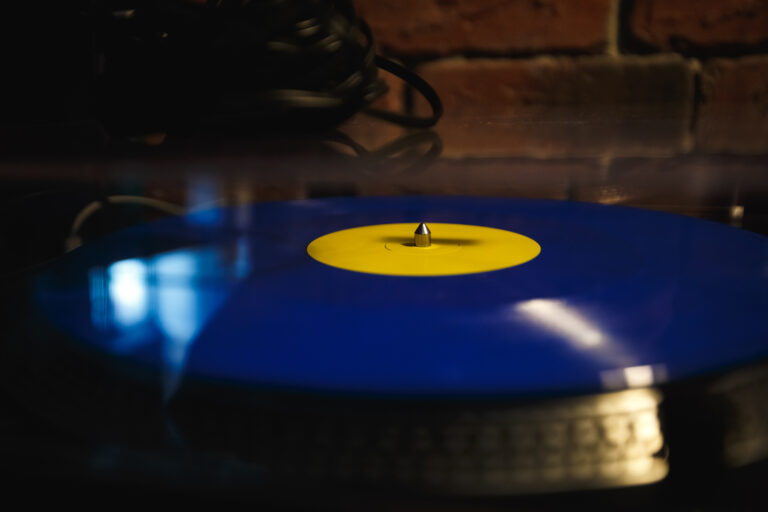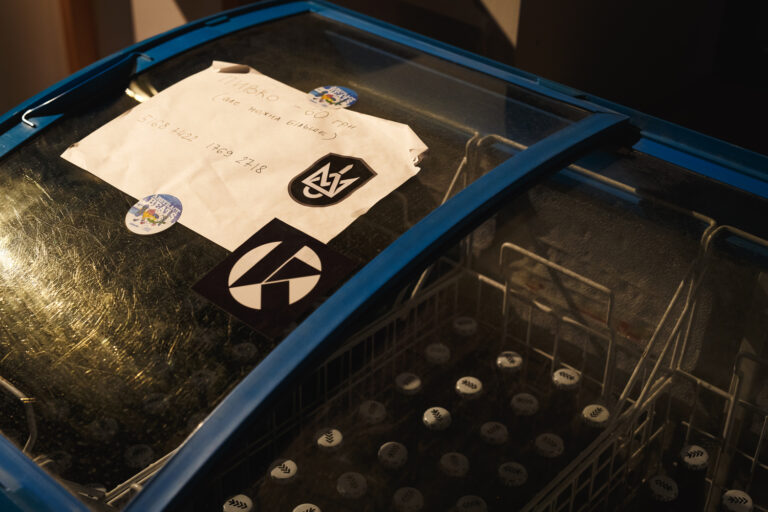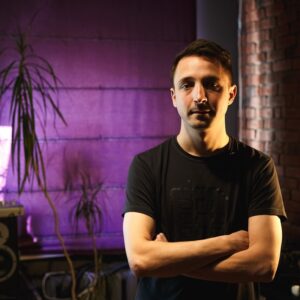Due to the full-scale Russian invasion, many cultural initiatives have switched their activities to help the military and civilians. However, their main mission to create art remains unchanged as the art evolves into a special weapon to encourage the nation’s spirit in these trying times and to bring forward victory. The art space Module in the city of Dnipro appears to be a brilliant example of artists who are helping simultaneously on several fronts.
The art space Module opened in Dnipro in 2016. This cultural centre was created to practise audiovisual art. The art centre had its own recording studios as well as a sound lab, a production studio, a concert venue, a film viewing room, a bar, a vegan cafe, and a shop. The team also ran a DJ school and had its own music label, Dnipropop. Later, Module moved to another location in Dnipro. The art centre brought together activists who, with the onset of Russia’s full-scale war in Ukraine, have been organising charity concerts and volunteering. They sew plate carriers, first-aid kit bags, and knee pads and also repair vehicles for the Armed Forces of Ukraine.
How the art space Module was founded
Yevhen Honcharov, the current art director of Module, organised parties and festivals back in 2005. He brought international artists to Dnipro and made exhibitions of modern art. Later, he joined efforts with Mykyta Kozachynskyi, and they decided to find a place of their own for such events. However, when the Revolution of Dignity and the Russian-Ukrainian war began in 2014, the project had to be put on hold. Yevhen and Mykyta returned to their plans a few years later and opened an art space in the former printing house.

Module mainly supported electronic music and alternative performance styles. The founders say that the Ukrainian word “mytsivnia”, which can be translated as art or artists’ space, best describes their activity: the space unites artists, and the word itself sounds original and very Ukrainian. It is easy to Google and has no equivalent in Russian.

At the beginning of 2022, the team had to leave the rented premises in seven days. The developer bought the entire plot to build an office centre or a parking lot. After the move, the Module team was planning to take a break and go for a skiing holiday in the west of Ukraine and to start looking for a new space on their return. However, these plans had to be postponed with the onset of the full-scale Russian invasion.
Module and the full-scale war
The art centre brought together enthusiastic people who, with the onset of a full-scale war with Russia, were able to quickly unfold volunteer activities and support the defenders of Ukraine. Some members of the Module community have gone to fight, and the rest have been dealing with a range of their needs. Yevhen Honcharov says that Module has become a virtual community with about 100 people in its chat. They are collecting supplies for those on the frontlines who have any connection to Module: ushers, sound engineers, and others. Such mutual support is very important these days.
“We share any request in the chat, and it is taken care of in 10 to 15 minutes,” Yevhen says. “Everyone is involved, everyone tries to help. Someone donates money, someone does networking, someone Googles and finds what is needed, then someone picks it up in their car and drops it off at my house. We joke that my house is like a NATO base: everything is brought there and then sent to our boys.”

According to Yevhen, life in the city of Dnipro has changed since February 24, 2022. Nearly everyone has become immersed in volunteering; people come together and help each other 24/7. Many public organisations and charitable foundations have reorganised their work, and new initiatives have appeared that help people adapt to the new realities of life in war conditions. This happened so fast because the residents of Dnipro have been living close to the frontline since 2014:
“The volunteer movement in Dnipro has become, in my opinion, more professional. Everyone works as one big family or as one big company. I mean, it is very structured and very professional. If there is a cultural centre, there is a very good chance that the community, which gathers around this cultural centre, will start volunteering, helping the army, or catering to some other needs.”

Equipment for the army
At the beginning of the full-scale war, Yevhen, the art director of the art space, asked Kateryna Rodycheva to sew plate carriers for the defenders from Module. According to Kateryna, they have known each other for a long time, since they painted the walls in Module together. Her mother, Alla Rodycheva, works in a workshop that made upholstery before the war but now sews plate carriers, first aid kit bags, and knee pads for the military. Kateryna says that the first days were the most challenging because people gave her number to others so her phone was bursting with calls.
“Some people waited for three weeks,” Kateryna says. “Then, also with the help of our community, we raised funds for our first sewing machine, then Sanya (director of the workshop — ed.) found more and more sewing machines. At first, we needed two or three rooms, then we had a whole floor of people who volunteered to sew. And so the volumes kept increasing and increasing. Now there is a slight decline — everyone is dressed — but people keep writing to me about their needs a couple of times a week. We do not turn down anyone.”

Some volunteers who wanted to help with sewing came with their own sewing machines. Some machines were rented out during the war. Plus, funds were raised for several new ones. In total, more than 10 sewing machines are in use. Kateryna says that at first, there was a problem with the fabric. They got materials wherever they could. For example, they searched for rolls of fireproof tarpaulin in warehouses. Kateryna’s mother, Alla, is a technologist for the production of plate carriers. She says that they make plate carriers taking into account the wishes of the military.
“We did not take an example from anywhere,” Alla says. “No one makes the kind of models we have made. This is because we ourselves developed it (the plate carrier. — ed.). The military came to us, they took them to the training ground, they wore them and said: ‘Here, we need to change this. And this will do it.’”

However, Kateryna notes that before achieving such results, they went to other workshops to watch how others make similar products to make sure that they were doing everything right.
The seamstresses say that the military asks, for example, to make pockets for grenades or specific systems for fastening equipment like a walkie-talkie. The seamstresses listen to their clients’ wishes, so as a result, after various improvements, they make quality products.

Alla explains her tireless motivation through the fact that she wants to protect the military with her work, as they protect all Ukrainians. She says that making such equipment is also a huge responsibility because during battles, of course, you cannot fix anything in those products. Therefore, the women put their hearts into sewing. Everyone understands: this plate carrier can go to someone’s brother, husband, son, sister, daughter, or mother. Therefore, seamstresses carefully consider all the comments and wishes of those who have already used their equipment. Kateryna and her mother take it seriously when checking the quality of the plates.
“I have feedback from the military, from the Territorial Defence teams, and when in doubt, I have a place where I can take them (plate carriers. — ed.), and they will be checked for me,” Alla says. “But from the beginning of the war until today, there was no reproach, only good reviews.”

Kateryna remembers how, right from the first days of the full-scale war, people came and helped. Volunteers collected strips of fabric that remained after cutting and wove camouflage nets from them. Everyone joined as much as they could, even for a few hours.
“We even had a woman who came to us after surgery with a walking stick,” Kateryna says. “She asked us to give her some work too.”

Repairing cars for the Armed Forces of Ukraine
The Module community helps to repair cars for the Ukrainian Armed Forces and raises funds for their purchase. Roman Korobkin, Yevhen’s friend, used to cycle with his friends to the Module yard and is now busy fixing cars.
“Our guys said that they need cars to be mobile and to be able to move from point A to point B,” Yevhen says. “As soon as they voiced their need, we started raising money for them, contacted people who bring cars from Poland, Latvia, and other countries, and asked them to find us cars for our needs. Of course, these are used cars, so they need additional repairs, and this is what Roman does.”

Car repair is a never-ending process. Yevhen drives one to hand it over to the soldiers and drives back a broken car to fix. Yevhen says that it is important to choose cars for which all the necessary spare parts can be found in Ukraine. Cars also need camouflage painting. One of the community members, a designer called Gosha, continually donated for painting (it takes 10,000 to 12,000 thousand hryvnias to repaint one car, and also developed a logo, which those on the frontlines now use as the chevron of their unit.

“Of course, the Land Rover is the most suitable model,” Yevhen says. “It’s easy to find spare parts, and they can be repaired quickly. Also, Mitsubishi pickups. And the last car we bought was a Mitsubishi hybrid. Why a hybrid? Because there are fuel shortages and electric cars can play a very important role, at least for the 40 kilometres that they can drive on a battery. These 40 kilometres can save a life when you run out of gas.”
Hybrid car
A car with an electric engine and internal combustion engine system; that is, it can go both on the charge of the electric accumulator and fuel.According to Yevhen, when you visit the frontline yourself, you get an even greater understanding of the importance of any assistance. He says that the war feels differently in Dnipro and other cities.
“Being there, at the frontline, is a chance to understand how things really happen,” he says. “You constantly hear shots, explosions. You learn to understand where the rockets took off and where they landed. And this is what gives you an understanding of how hard this work is and how dangerous this all is. And how hard this all is for these guys who protect us on the frontlines.”
Curfew Jazz
Despite such active assistance to the military at the front, the team of Module keeps on making art. It is just that now they use it mostly as a powerful fundraising tool. People can both emotionally discharge themselves and do a good deed for the benefit of Ukraine.

Together with Andrii Palash, director of the Dnipro Center for Contemporary Culture (DCCC), Yevhen organises parties to help raise funds for the needs of the military. For instance, money for the repair of cars of the Armed Forces of Ukraine is raised through musical events like Curfew Jazz or events at the Tea House. Yevhen says that after the first month of the full-scale war, the Module team understood that people need “access to culture” to distract themselves a bit and to uphold their spirits. DCCC had free space, and Module had equipment, so they combined efforts.
“We play vinyl records, play music,” Yevhen says. “People come, they make donations, and thanks to this, we raise funds. It is what we do offline. Online, we constantly write posts, contact people who used to live in Dnipro and moved somewhere in Europe, and they donate too. We estimate that we had probably raised somewhere around one and a half million hryvnias (as of December 2022, it’s more than 40,000 USD – ed.). And with all these funds, we have the opportunity to help boys and girls (at the front).”



slideshow
At these parties, people listen to modern music, meet friends, buy drinks and raise money to help the Armed Forces of Ukraine. So far there have been over 10 such events. At first, mainly performers took part, but now performers from other cities joined in. Yevhen adds that the guys at the front are also asking them to share some music or videos to see how the peaceful city lives:
“It lifts their spirits, and they like it. You can read many posts where they say, ‘While you’re alive, while you can — hang out, have fun, don’t worry. Do everything as if it were the last day of your life.’ Every day something can ‘fly in’, everything can end. So why sit and be afraid if you can act and at the same time help our boys?”

When Module reopens in a new location, Yevhen wants to hang there the Ukrainian flag, which was signed by his friends from the front. And he will continue to fight for his country.

The creative community of Module is constantly in touch with various artists, asking them not to forget about Ukraine and to cancel Russian culture, that is, to refuse to consume and popularise any content of the aggressor state. Yevhen believes that is how, bit by bit, everyone can make their small contribution. And sooner or later, these efforts will have a powerful impact that will defeat the evil empire.
supported by
Цей матеріал створено за підтримки ІСАР Єднання у межах проєкту «Ініціатива секторальної підтримки громадянського суспільства», що реалізується ІСАР Єднання у консорціумі з Українським незалежним центром політичних досліджень (УНЦПД) та Центром демократії та верховенства права (ЦЕДЕМ) завдяки щирій підтримці американського народу, наданій через Агентство США з міжнародного розвитку.


